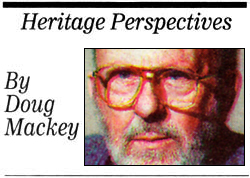 |
April 3, 2009Penguin Books Extraordinary
Canadians Series Expands
|
A year ago Penguin Canada Books
started a series of 20 hardcover,compact
biographies about outstanding Canadians by outstanding authors with cover
portraits by outstanding artists. Not a bad idea! I briefly wrote about Emily
Carr, Lord Beaverbrook and Nellie McClung last year (see my website for April
11/2008). All were written by well known Canadian authors and were well done.
Since then books on Pierre Elliot
Trudeau and Big Bear (1825-1888) one of
Canada’s most important aboriginal leaders and others have
come out in bookstores. The Trudeau and Big Bear books are by Nino Ricci and
Rudy Wiebe respectively, two of Canada’s best known
authors. The covers are eye catching.
The series’ General Editor is John
Rolston Saul who has written many books including
his recent A Fair Country: Telling the Truths About
Canada. Saul is married to Adrienne Clarkson our former Governor General
(1999-2005) who has written one of the series books on Dr. Norman Bethune the
brilliant and iconoclastic doctor. Saul will also write one of the books. The
series has been called “the most ambitious set of biographies ever published in
this country”. Most of the extraordinary Canadians written about in the series
have had extensive and often scholarly biographies written about them already.
Penguin thinks that high quality 150-200 page biographies by outstanding
Canadian authors written for the general public have an important role for the
thousands of readers who would stay away from lengthy tomes. I have read a
couple of the Penguin books and think they are great and I look forward to
reading more. I have read extensively on Dr. Norman Bethune and look forward to
the new book on him by Adrienne Clarkson out this month.
Dr. Norman Bethune
Penguin says their books are about
“rebels, reformers, martyrs, writers, painters, thinkers and political
leaders”. Dr. Norman Bethune belongs in most of these categories and has been
called “perhaps the most famous Canadian who ever lived” which stretches it a
bit.
 |
Norman Bethune operating in
China. A Chinese stamp based on this photo
was widely distributed in China. |
Before looking at Bethune it should
be mentioned that his genius was tainted or made interesting, depending on your
point of view, by a rebellious and egocentric, compulsive personality that
offended many. Like some of my favourite Canadians such as Grey Owl, and Glen
Gould, Bethune died before age 50 making his career all the more remarkable.
Bethune was born in
Gravenhurst where his father was a Presbyterian
Minister. His grandfather was a highly successful doctor and professor. The
family moved regularly and Norman very early
showed remarkable independence and a forceful personality.
Roderick Stewart wrote a highly
successful book called Bethune in 1973 and another The Mind of Norman Bethune in
i977.
Stewart recorded Bethune’s movement
from University to a lumber camp on Georgian
Bay where he taught the lumberjacks to read, to Medical School and to Europe in
WWI. When wounded he returned to Medical School and got his degree and went
back to Europe. He married, divorced and remarried the same beautiful woman.
When he got T.B. at age 36 he insisted on a new and untested treatment and
recovered and became a specialist in Thoracic surgery and moved to Montreal.
While there, he wrote articles and designed equipment that improved medical
practice. He was an artist and poet and led an active social life.
His social conscience led him to
offer free clinics in Montreal for the poor and
he became critical of the social system. He visited Russia and became a member
of the Communist Party of Canada. In 1936 he went to Spain to fight the
fascists in the Spanish Civil War. His development of a mobile blood-transfusion
unit saved many lives and set a trend. His experience in Spain is recorded in a
chapter in the 2008 book Renegades: Canadians in the Spanish Civil War where his
brilliant and driven personality are profiled.
Bethune’s most remarkable achievement
was his move to China during their war with
Japan where he developed front line medical practices that saved hundreds of
lives. He taught many other medical people there to do the same. On one
occasion he operated on “115 patients non stop over
sixty four hours.” On another occasion in 1939 he cut himself and died of blood
poisoning. He is a hero of the Chinese people, the medical profession, and many
Canadians.
His original
Gravenhurst home was made into a museum by Parks Canada. On the 70th
anniversary of his death Place Norman Bethune was established near
Concordia University in Montreal with a huge statue of
Bethune on the square. Hospitals have been named after him.
He has been celebrated in
Spain and China as well for his work. The McCord
Museum in Montreal has an exhibition on him this spring. The National Film
Board did a film on him years ago and a feature film Bethune: The Making of a
Hero was made in 1990 staring Donald Sutherland as Bethune. It was based on a
novel by Ted Allen.
Adrienne Clarkson has quite a task to
add to the existing material on Bethune in libraries and online. I will be one
of the first in line for the book and some of the others in the series.
 |
Cover of new book on Dr. Norman
Bethune. |
For further information on the series
log on to
http://www.extraordinarycanadians.com/ .For
information on Bethune Google his name. One of the most interesting
sites is
http://archives.cbc.ca/health/medicine/topics/1345/ which has 6 television
clips and 8 audio clips covering his life.
Heritage Perspective Home Page
| 
![]() Past
Forward is now on Facebook "LIKE" us to keep in touch
Past
Forward is now on Facebook "LIKE" us to keep in touch